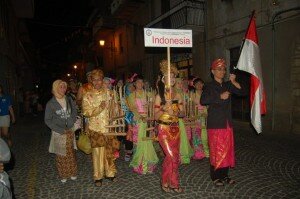
Everyone knows that angklung is a traditional musical instrument, and it’s made from a particular bamboo that only grow in Indonesia. But, not many Indonesian knows that angklung is also popular in European countries. Wanna know why? Because Keluarga Paduan Angklung SMAN 3 Bandung made that happen.
KPA 3 is an angklung music group consisting of SMAN 3 Bandung students. There are many breakthroughs they made in angklung world, and one of them is ESA, Expand The Sound of Angklung. ESA is an event where KPA 3 joined music festivals in Europe. Since 2002, there have been 4 ESA, and here is the list of international music festival and awards they have achieved:
1. Expand The Sound Of Angklung 2002, a cultural visit to several European countries from 16 July – 9 August 2002, and participated on international events, as follows:
- 29th International Folklfestival in Gannat, France.
- 19th International Folklfestival in Moerbeke-Waas, Belgium.
- Expand The Sound of Angklung 2002 also held two concert in Heidelberg and Kiel, Germany.
2. Expand The Sound Of Angklung 2004, a cultural visit to several European countries from 22 July – 28 August 2004, and participated on international events, as follows:
- Aberdeen International Youth Festival (AIYF) in Aberdeen, Scotland This festival is the biggest youth festival in the world, which focusing on development of music and theatre of youth.
- 36th International Festival of Mountain Folklore in Zakopane, Polandia This is one of the oldest competition on folk tradition. KPA3 is invited as the first participant ever from Indonesia. In this festival, KPA3 achieved 3 trophy, as folows:
2004 – 1st place in musician category of 36th International Festival of Mountain Folklore, Zakopane, Republic of Poland
2004 – 2nd place in singer category of 36th International Festival of Mountain Folklore, Zakopane, Republic of Poland
2004 – Audience prize of 36th International Festival of Mountain Folklore, Zakopane, Republic of Poland
- 50. Mezinárodni Folklorni Festival, ?erven? Kostelec, Czech Republic In this festival, KPA3 achieve 1st audience prize of 50. Mezinárodni Folklorni Festival, ?erven? Kostelec, Czech Republic Expand The Sound of Angklung 2004 also held four concert in Bremen & Muenchen (Germany), Paris (France), and Brussels (Belgium).
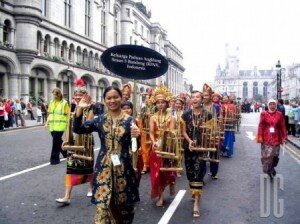
3. Expand The Sound Of Angklung 2008, a cultural visit to several European countries from 15July 2008 – 7 August 2008 and participated on international events, as follows:
- 2008 International of Petras, Greece § 2008 Norbanus Festival at Norma, Italy.
- 2008 Festival of Rassegna at Castigleone del Lago, Italy.
- 2008 International Society of Music Education International Conference at Bologna, Italy.
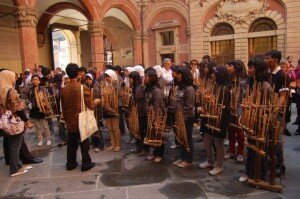
4. Expand The Sound Of Angklung 2010, June 29th – July 29th, 2010. KPA 3 joined 4 festival:
- International Festival Folkart Maribor ( June 29th – July 3rd, 2010 ) Organized annually under the patronage of the International Council for Organizations of Folklore Festivals and Folk Art (CIOFF), the International Festival Folkart, Maribor is an important platform for folklore groups and musicians. The festival takes place at various venues: the central stage is a floating stage on the river Drava and there are also several open-air stages in squares and streets all over the city of Maribor,Slovenia.
- Summa Cum Laude International Youth Music Festival Vienna ( July 3rd – July 8th, 2010 ) Hosted by VIA MUSICA (Vienna International Association for Music and Culture Exchange) and provides a unique platform for the world’s most talented youth choirs, bands and orchestras to perform in Vienna’s magnificent Musikverein..The six-day Summa Cum Laude Festival was expanded to include both the Summa Cum Laude Competition as well as the Summa Cum Laude Celebration. KPA 3 achieved a special award and was honored to perform in the gala winner.
- International Folk Festival (Festival Internacional de Folklore) of Ciudad Real (July 13th –July 20th, 2010) Organized by Association of Songs and Dances of Ciudad Real (Mazantini Group), International Folk Festival (Festival Internacional de Folklore) of Ciudad Real is held every year in mid-July. This festival is part of the International Council of Organization for Folklore Festivals and Traditional Arts (CIOFF).
- International Folk Festival (Festival Folklorico Internacional) of Extremadura, Badajoz (July 21st –July 29th 2010) Beginning in 2003, International Folk Festival (Festival Folklorico Internacional) of Extremadura, Badajoz is organized by The Federation of Folklore Extremadura. This festival gives opportunity to perform a dance or music indigenous to their town or area and learned by another group or associations.
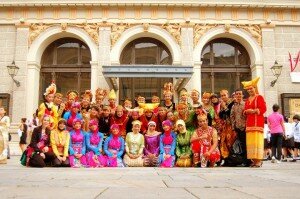
KPA 3 is well known because of its achievement in angklung world. Beside ESA there are many local music festival they’ve joined and awards they’ve earned.
GNFI had a great opportunity to interview Nabila Putri Kencana and Vica Asrianti, members of Keluarga Paduan Angklung SMAN 3 Bandung. Both of them were very delighted to tell GNFI about the experiences they had when they were abroad. Nabila, who recently graduated from SMAN 3 and is now studying management in UNPAD, went to Europe with ESA team in 2008. While Vica, SMAN 3 10th grader, went to Europe with the team in June to July 2010.

Nabila Putri Kencana
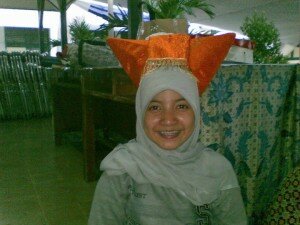
Vica Asrianti
GNFI: When was KPA established?
Vica: KPA was established in October 4, 1980.
GNFI: What started ESA in the first place?
Vica: In 2002, there were some students who wanted to expand KPA and angklung. They wanted angklung to be popular not just in Indonesia, but also in other countries. Some alumni came up with the idea of going abroad and not long after that, they coincidentally received some invitations from cultural events. The first festival KPA joined was the 29th International Folk Festival in Gannat, France.
GNFI: That’s awesome! How many ESA have been held ever since?
Nabila: Four. ESA 2002, 2004, 2008, and the latest was 2010.
GNFI: Is it always in European countries?
Nabila: Yes it is. Because we always go there when we are in school holiday, and at the same time it’s summer in Europe. There are many cultural festivals held every summer, unlike America. That’s why we focused on going there.
GNFI: I see. How many students are in the team usually?
Nabila: There are 35 students with one teacher.
GNFI: That’s a lot of number! How many of them play angklung? Is there anything else they do beside playing angklung?
Vica: All of them. Beside playing angklung we also dance traditional dances like saman, jaipong, jali jali and balinese dances on stage.
GNFI: Are you saying that all of the students can dance? They’re not only playing angklung?
Nabila: In 2008, the were only few of the students who can dance.
Vica: But in 2010, all of us can dance. Most of us even had to learn more than one traditional dances. If we’re not playing angklung, then we dance.
GNFI: How about the costumes?
Vica: We brought angklung costumes, traditional costumes and dancing costumes.
GNFI: How many singer do you usually have in team?
Nabila: Only one person sings. But all of us also sing in a particular song, like Rayuan Pulau Kelapa.
Vica: That’s right. I even cried when I sang that song.
Nabila: Me too.
GNFI: Really? What made you both cry?
Vica: We were just very proud of hearing Indonesian songs in foreign country. And it was also a heart-rending moment seeing Indonesian’s flag, proudly standing next to other countries’ flags.
GNFI: I couldn’t agree more. And how about the audience? Did those foreigner enjoy your performances?
Nabila: Surprisingly, they did. Some of them even kept following us in every performances, because they really liked us.
Vica: Yes, it happened to me and my group too. When we were in Badajoz, there was an old photographer who really liked us. By the end of our performance, he gave each of us a CD of our photos. He also printed some photos and signed it.
GNFI: Wow, that’s truly amazing!
Vica: Indeed. Their responses were very great, better than we received when we played in Indonesia. Foreigner were amazed to see angklung.
Nabila: They are… they’re just very curious to know how an odd looking musical instrument like angklung could make beautiful sounds.
GNFI: When you played in Indonesia, the responses weren’t that good?
Vica: I have to admit that in Indonesia, people like to see us but they’re not interested in preserving the cultures.
GNFI: I see. Back to ESA, what else did you do beside performing on stage?
Nabila: We also sold some Indonesian souvenirs.
GNFI: Really? What kind of souvenirs?
Nabila: Angklung, angklung’s badge, CD midi angklung, blangkon, kecapi miniature, wayang golek, batik bed cover.
Vica: Batik shirts and scarfs.
GNFI: Cool. And did they like it?
Vica: They did. There were many customers who bought our batik scarfs. It was a real fun selling those in foreign countries. It made us learn their languages.
Nabila: It was pretty hard when we were in Italy. Many Italian don’t speak English, so I used my body language to tell the the prices. It’s kinda funny but I got some skills after that. Skills to sell something.
[End of interview]
See? Their stories are just amazing. I had a great time interviewing them. Anyway, if you wonder what songs that KPA 3 usually play abroad, here is the list:
- Ludwig van Beethoven Symphony No. 5 in C Minor, Op. 67,
- Mov. I Allegro con brio Clément Philibert Léo Delibes Pizzicati from The Ballet “Sylvia”,
- Act III Johann Strauss, Jr. Wiener Blut Walzer, Op. 354 Johann Strauss, Sr. Radetzky March, Op. 228 Jacques Offenbach Orpheus in the Underworld Overture: Infernal Gallop
John Towner Williams Williams’s Suite of Score – from John Williams Music Scores
- Andrew Lloyd Webber Memory from the Musical “Cats”
- Giuseppe Fortunino Francesco Verdi Libiamo ne’ lieti calici (The Drinking Song) from The Opera “La Traviata
Eros Djarot Suite from Badai Pasti Berlalu
- Guruh Soekarno Putra Melati Suci
- Halo-Halo Bandung
- Medley Persada Indonesia
Lalayaran – Hariring Haleuang Tembang (traditional Sundanese)
- Es Lilin (traditional Sundanese)
- Jali – Jali (traditional Betawi)
- Janger (traditional Balinesse)
- Tapanuli’s Splendor (Series of Batak folksong)
KPA 3 has proved to the world that our traditional musical instrument and folk songs are amazing. By the way, KPA 3 is preparing for its next concert. If you’re interested in watching it, just let me know 
Photo Source: Private collections
Thank you Ms. Nabila Putri Kencana and Ms. Vica Asrianti for the time!
Popularity: 4% [?]













